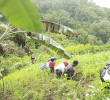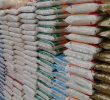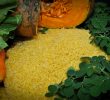DAVAO CITY – Davao Oriental province will take the lead in the Davao Region in shifting to oil palm plantation to address the concern of coconut farmers whose livelihood were hit hard by Typhoon Pablo in 2012.
This was revealed by Provincial Governor Corazon Malanyaon during the Regional Development Council press briefing last Thursday.
Malanyaon announced that the province has identified and could allot 4,000 hectares as minimum requirement for oil palm production as set by Agusan Plantation Inc. (Agumil) Philippines, a leading oil palm exporter based in Caraga Region.
She said the areas are in the three towns of Boston, Baganga and Cateel, the hardest hit areas of the typhoon.
The Land Bank of the Philippines will extend financial assistance though loans payable in five years, the governor said.
The shift is made to find stable and faster sources of income after Pablo hit and left farmers wanting for livelihood, Malanyaon said.
Davao Oriental is the country’s leading producer of coconuts with an average yield of one billion nuts annually covering area of 156,837 hectares, according to its provincial government website.
Typhoon Pablo destroyed the province’s agriculture at a cost of P450 million, according to a post-disaster report.
“I thought we have enough with coconuts. It seemed it promoted farmers not to strive hard to do something else,” Malanyaon said.
The governor said she is “sold out” to oil palm production after seeing how this agro-industry product helped boost the economy of Malaysia.
In its website, theprovincial government said it consulted early this year local farmers, mayors and head secretary of the Provincial Oil Palm Development Council Pablito P. Pamplona.
Pamplona said oil palm has a yield potential of over 60 tons of fresh fruit bunch per hectare.Oil palm produces yield in three years as compared to the seven-year growth of coconuts, and is viable for inter-cropping.
Malanyaon said other provinces will be joining in this venture.
“We talked with Governor del Rosario (Davao del Norte) and Governor (Compostela Valley Arturo ) Uy, and we agreed that the region will be an oil palm area,” she said.
In the RDC meeting, Del Rosario said the venture into oil palm is also part of the region’s readiness for the Southern Mindanao Growth Corridor as outlined by the Mindanao Development Authority.
Davao del Norte however, will focus in rice and chocoloate production, as he bared the three towns to be the center of chocolate production for the local and Asian market.
He said the province can seek assistance in the ASEAN community to boost its rice production.
“Davao del Norte is the biggest rice producer in Region 11, and has been self-sufficient in its rice production, and is helping feed Davao City, and we like to improve on that,” del Rosario said.
Chocolate production will be in San Isidro town, dubbed as the province’s “chocolate capital” for producing tabliya to five-star hotels.There will also be planting processing of chocolates in the neighboring towns of Kapalong and Asuncion as areas for cacao plants and chocolate processing.
The national coconut farmers group Kilusang Magniniyog appealed to government.
Meanwhile, to go beyond its copra-industry framework and to fund an integrated coconut processing hub to utilize more coconut-based products. (davaotoday.com)










